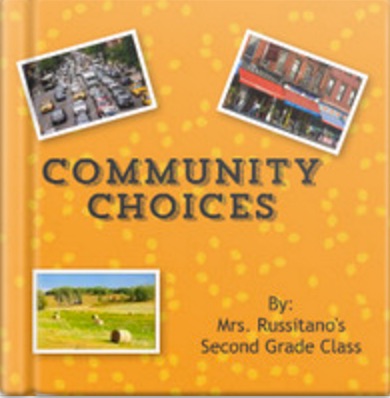 South Side Elementary School students study communities, publish digital books
South Side Elementary School students study communities, publish digital books
Each year, the second grade students at South Side Elementary School study types of communities as part of their social studies curriculum. This year, their teachers took a new approach, collaborating with Canastota Central School District’s Instructional Technology Department to create an integrated, Project Based Learning unit about types of communities. As a result, the students not only delved deeper into the subject matter, but learned new research skills and became authors of their own digital books.
This past spring, 2 nd Grade teachers Katrina Mercer, Carrie Malbouf and Lori Russitano partnered with Chris Clancy, Director of Instructional Technology, to integrate technology their unit about types of communities. Their students had been using new Chromebooks throughout the school year for various activities, and the teachers wanted to use the computers as part of a specific Project Based Learning activity.
The Buck Institute for Education (bie.org), defines Project Based Learning as a teaching method in which students gain knowledge and skills by working for an extended period of time to investigate and respond to an engaging and complex question, problem, or challenge. According to Mr. Clancy, the project they developed required students to learn new research skills with online databases
According to Mr. Clancy, the project they developed required students to learn new research skills with online databases and printed books, organize their research, present their findings, and write and publish a digital book.
“The students worked in teams that were assigned different types of communities to research – rural, suburban, and urban,” Clancy says. “The team members worked collaboratively to research and write about their assigned community types. They used their Chromebooks and a website called Mixbook.com to publish books about the communities.”
Lori Russitano says the project was very motivational to both students and teachers alike.“This gave some students the
“This gave some students the opportunity to be technology leaders and assist others with creating their Mixbook page,” she says. “And we have a better understanding of the time we need to devote to a project of this extent.”
Katrina Mercer believes the use of technology meant students could pick their learning parameters. “It lent itself to a differentiated project as students wrote to their own abilities without pressure. Students took ownership of their digital book page.”
“It lent itself to a differentiated project as students wrote to their own abilities without pressure. Students took ownership of their digital book page.”
Clancy says that for this project, the role of teacher and student changed.“In a traditional learning
“In a traditional learning environment, a teacher delivers information to the students and then the students do something with that information. In this case, it shifted because students were really responsible for much of their own learning. The technology provided students with a way to find some of that information, gave them additional resources and tools, and provided a different way to demonstrate their understanding of the subject.”
The project concluded in June, and Clancy finds the students are better prepared to take ownership over their learning.
“They’ve gone through the research process as second-graders, which I think is really powerful. They have new tools for their learning toolbox, so the next time a teacher asks them to research, they use some of those tools. Not only did the use of technology and Project Based Learning help them learn, but gave them skills to take on to 3 rd grade.”
Carrie Malbouf thinks the teachers benefited, too, stating, “After completing this first project, we are excited to try to incorporate more technology to further enhance our curriculum.”
Links to the digital books:
Mrs. Malbouf’s Class Book: http://www.mixbook.com/photo-books/interests/types- of-communities- 13827514?vk=mK4wXkUjgU
Mrs. Mercer’s Class Book: http://www.mixbook.com/photo-books/interests/types- of-communities- 13822879?vk=mK4wXkUjgU
Mrs. Russitano’s Class Book: http://www.mixbook.com/photo-books/interests/types- of-communities- 13827551?vk=mK4wXkUjgU

When learners are engaged in relevant activities they learn more and perform better. Activities makes them concentrate on the topic. So activities are also attention-holding.
Having a finished product that others can access outside of the learning community should be a game-changer. I’m thinking this could even have exploded impact if tackled together with other communities elsewhere.. give it an international flavor.